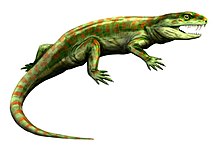Eothyris
| Eothyris | |
|---|---|

| |
| Holotype skull | |
| Scientific classification | |
| Domain: | Eukaryota |
| Kingdom: | Animalia |
| Phylum: | Chordata |
| Clade: | Synapsida |
| Clade: | †Caseasauria |
| Family: | †Eothyrididae |
| Genus: | †Eothyris Romer, 1937 |
| Type species | |
| Eothyris parkeyi Romer, 1937
| |
Eothyris is a
Discovery and naming
Eothyris parkeyi was one of many new species of "
Description

Eothyris is known only from its complete skull, however, the postcranial skeleton is unknown. Its skull is short and broad with a total skull length of 5.7 cm (2.25 in), Benson et al. estimated the body to be 30 cm (12 in) long.[6] The major distinguishing features of the skull are that it possessed a pair of long, large, fang-like teeth on each side of the upper jaw. The main differences between Eothyris and Oedaleops are related to the degree of specialization in the dentition of the geologically younger Eothyris.[7]
Skull
The superficial dermal elements are preserved, and the
Teeth
As Eothyris parkeyi has a short face, the lower
Classification
Eothyris is classified in the monophyletic family Eothyrididae. It is one of two genera in the family, the other being Oedaleops. The family is grouped in Caseasauria, and only cranial remains are known from it. The family is greatly supported, with nine dental and cranial features.[3][12] Below is the cladogram of the analysis of Reisz et al. (2009).[9]
| |||||||||||||
Paleobiology
The short face and dental structures represent an extreme type of development of predaceous habits far off from those in a pelycosaur ancestor and entirely distinct from the milder dental differentiations of ophiacodontids. The skull measure of Eothyris parkeyi is extremely small for a pelycosaur. Eothyris parkeyi is represented by a complete skull, but the postcranial skeleton is unknown. Therefore, there is the little foundation to diagnose the extended family. Also, the skull of Eothyris parkeyi is described according to that form. Whether many of the striking primitive features were repeated in other genera is unknown.[2][3]
The order of the portion of bones in the skull roof of Oedaleops and Eothyris parkeyi conforms to a basic pattern in primitive reptiles and is shared with various groups such as millerosaurs and captorhinomorphs, and ophiacodonts.[7] The major distinguishing features of the skull are that it possessed a pair of long, large, fang-like teeth on each side of the upper jaw.[9] The use for these teeth is not known, but Eothyris parkeyi might have used them to eat small prey. All teeth in its mouth were sharp, with all but the enlarged four fangs being small and short. The skull is short and broad, two features which suggest that Eothyris parkeyi had a snapping, rapid bite.[2]
Dental specializations are related to predaceous habits. The Eothyrids tended to be dominant types and it is interesting that except for little Eothyris parkeyi, which may be considered as a small late survivor. Its teeth suggest that it was a carnivore, but because Eothyris parkeyi is known only from a skull, it is difficult to say much else about its way of life.[3][7]
References
- ^ "†Eothyris Romer 1937". Paleobiology Database. Fossilworks. Retrieved 17 December 2021.
- ^ a b c d e Romer, Alfred Sherwood (1937). "New genera and species of pelycosaurian reptiles" (PDF). Proceedings of the New England Zoölogical Club. 16: 89–97. Archived from the original (PDF) on 2 December 2018.
- ^ doi:10.1130/spe28-p1.
- PMID 27333277.
- ^ .
- OCLC 964422674.
- ^ a b c d e Langston, Wann (1965). "Oedaleops campi (Reptilia: Pelycosauria): new genus and species from the Lower Permian of New Mexico, and the family Eothyrididae". Bulletin of the Texas Memorial Museum. 9: 5–47.
- S2CID 198140317.
- ^ S2CID 85602931.
- ^ ISSN 0008-4077.
- ^ S2CID 140172207.
- PMID 24739998.
